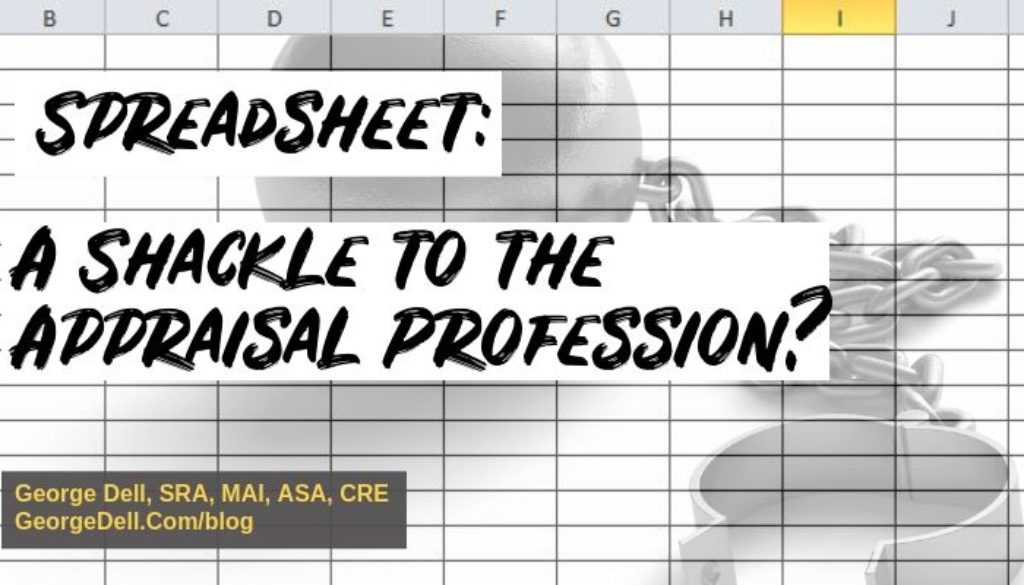How can spreadsheet software hinder the profession? A Wall Street Journal article, and a presentation at the Appraisal Institute National Conference have similar stories. One addresses accountants, the other is about appraisers.
Editors Note: The Stats, Graphs, and Data Science classes taught in Detroit the week of September 23-27, 2019 included the first ever meeting of the Community of Asset Analysts. The CAA is holding our 3rd Annual Conference in Palm Desert, CA, January 24, 25, 26, 2024. For More Information go to Valuemetrics.Info/conference.
The Wall Street Journal Article is titled: Stop Using Excel, Finance Chiefs Tell Staffs, “Ubiquitous spreadsheet software that revolutionized accounting hasn’t kept up, CFOs say”. The CFOs note several ways in which spreadsheets have fallen behind:
- How errors bloom, because of separation from other systems
- Difficulties in multiple users, particularly in older versions
- Limits to the amount of data that can be used in a single document
- Time in distributing spreadsheets to multiple leaders
In general, the limitations persist because of the age of the product, as well as the “add-on” nature of many additions to the original “adding columns” nature of bookkeeping needs.
The 2015 AI meetings presentation: Will Appraisers Have to Learn to Use Real Analytics Software? was given by George Dell. The main point was that accountant’s software was primarily developed for record-keeping, mimicking paper columns and rows, with analysis a later goal. Other points are:
- Validating and tracking data is difficult.
- No built-in audit trails, nor tracking of changes.
- Regulatory compliance is difficult to accomplish.
- Susceptible to trivial human errors.
- Difficult to troubleshoot or test.
- Poor scalability.
Spreadsheets are not ‘statistical’ software. Nor are they designed for modern data science, which deals with ranges of data from very small to very large, instantly available on the internet. Valuation incorporates data gathering, data selection, and prediction. Each of these requires different skills, and different computation algorithms. Each clarified in the use of R and related packages.
It is beyond time for the appraisal profession, and its professional organizations to begin teaching and formulating strategy to re-energize, and capitalize leverage the knowledge and experience of members’ expertise. This means the use of software built from the ground up for analytics, not record-keeping. The R environment exactly integrates the new skills, refined judgment, and improved techniques, as suggested in The Appraisal of Real Estate, 14th ed. p.95.
To this end, we are bringing modern analytics software, open source as the future of the profession: for individual appraisers, our professional groups, our clients, and the public trust. Many progressive leaders, who see the need for change and today’s technological competence – will be attending the classes, and/or our lunch organizational meeting on Wednesday, September 25, near the Detroit Airport. For further information, please go to georgedell.com for the weekly blog, or Valuemetrics.info for the meeting.

July 31, 2019 @ 8:03 am
Your class SGDS was eye opening. It’s revolutionized the back end of my report. I would actually like to take it again before I take the SGDS2. Great class. Definitely should be mandatory for every appraiser nationwide.
August 13, 2019 @ 7:44 pm
Agreed a second go round in the SGDS2 is needed on my end as well. Key phrase in the class and in developing an analysis is “all of the data”
August 13, 2019 @ 8:34 pm
You may want to consider SGDS 1 and SGDS2 coming up in Detroit.
We will also be formulating ideas for building a community of analysts committed to modern methods.
Join us for a lunch meeting September 25, 2019.
December 4, 2019 @ 2:36 pm
Any chance you will come to Florida?